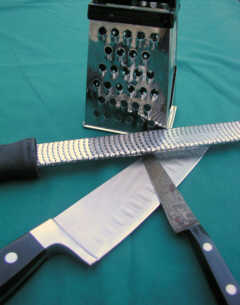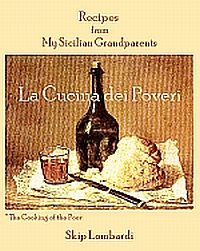Living on $42.00 per Week-Day 5
July 20th, 2007Lunch Thursday:
Lunch today was catch-as-catch-can. One of us had a dental appointment that caused involuntary facial contortions from Novocaine, and the other had mid-day business in Lakewood Ranch.
When we finally came together for a meal, it was nearly 3:00 p.m., and we were (metaphorically) “famished.” Knowing that this is when we or anyone is most likely to succumb to indiscriminate snacking, we did not simply plunge into the larder in search of instant gratification. Instead, we made a simple salad of 1/2 an avocado, a plum tomato, chopped Italian parsley, the grated rind & juice from half a lime, a squirt of hot sauce, and 2 tablespoons of sunflower seeds. (We buy ours in bulk, dry-roast them in the toaster oven and keep them on hand for occasions like this.) We had our salad with a two heated rounds of whole wheat pita bread. We took no more than 10 minutes to prepare everything, and there was just enough food to take the edge off until supper. Furthermore, we had a chance to sit down, talk, and relax a bit in the midst of a very busy day.
Kitchen tools: (Williams-Sonoma will hate us)

We began this project with a toolkit: Interest, enthusiasm, experience, appetites, and skills. But we couldn’t have implemented much of what we’ve done without tangible tools. For years, we’ve been reading about “the one kitchen tool” some rock star chef “can’t live without.” In our case, we can’t identify just one, but here, in no order of priority, are four inexpensive tools we feel every kitchen should have.
A Box Grater. We admire Mario Batali for his ability to create a snow-shower of Parmigiano with his Microplane grater. We question how much of the cheese finds its way onto the food, but it looks spectacular on TV. For most of our basic grating needs though, we rely this old standby.
A Chef’s Knife. We’ve read and heard all the hype about Wusthof, Henkel, Global, and recently, Kyocera. But for us, our knives (with or without pedigree) must be comfortable to be useful. And any knife can be sharpened. We found our Sabatier Santoku knife at T.J. Maxx for $9.95. It’s the bargain end of the Sabatier line but it feels good. However, before we brought it home, we took it to our local True Value hardware store and had it professionlly sharpened for $4.00. Now we have a tool that’s a pleasure to use in the kitchen. We simply give it a few swipes with a sharpening steel and make short work of whatever we chop or slice.
A Paring Knife. Ours is so old, we’re no longer sure where we bought it. But it, too, is French. Made from carbon steel, it has been professionally sharpened as well. It’s an invaluable instrument for the finer jobs we do in the kitchen, like dissecting meat from fish frames.
A Microplane Grater. At approximately $12.00, some might perceive this as a luxury. Beyond its obvious use for grating hard cheeses, this is sine qua non for grating citrus rind, fresh ginger, and carrots. We’ve even used it for making extra-fine bread crumbs. With the capabilities it’s given us, it has paid for itself many times over.
Supper Thursday:
After our ceviche meal, we banked our greatest bargain: we froze the Whole Foods halibut frame until we could afford it the time and thought it deserved. The Novocaine had worn off and one of us was still feeling a little sore, so a hearty soup seemed a good choice for supper. Cue in the fish frame…
In a large pot, we barely covered the fish frame with 10-12 cups of water. At this stage, our only seasonings were two bay leaves and about twenty black peppercorns. We brought the pot to a simmer; the broth began to perfume the kitchen. And we really mean that. There’s a reason professional cooks hold pricey halibut in such high esteem. Our broth was not fishy, but fresh—like an evening at the beach. As the broth hovered around a simmer, we began to gently scrape at the bones to release whatever meat still remained on the frame.
We’d planned to add some pieces of inexpensive frozen ocean perch ($3.49 for a 1 lb. bag at Sav-A-Lot, and we did have some in our freezer). However, we’d already gleaned more than a cup of halibut from the frame. The wafting stockpot aroma was so pure that we began to say things like, “You know, we may not need to add any more fish or seasonings…” But we did put one whole carrot into the stock, which we removed and reserved later, while it was still intact.
After about an hour, we strained the stock into another pot and picked as much of the meat as we could from the cooked bones. When we were done, we definitely had enough halibut meat for two.
But then, being foodies, we faced a dilemma: we wanted a simple preparation that would not obscure the halibut flavor. We had thought briefly about cotriade, a very simple fish soup from Brittany, and we had considered a minimalist version of soupe de poisson, the classic Provençal fish stew, which would have demanded olive oil, tomatoes, a bouquet of herbs, and saffron (all of which we had within reach). But to best illustrate frugality with flair, we chose the classic Mediterranean egg and lemon soup frequently known by its Greek name, avogolemono. The mixture can also be a sauce—enhancing poultry, meat, fish, and vegetarian dishes throughout the Eastern Mediterranean. It’s a great way to stretch a couple of eggs and a single lemon.
Four small, red-skinned potatoes, cut into bite-sized pieces and 4 cloves of chopped garlic went into the strained, simmering stock.
Into a separate bowl, we grated the rind of one lemon, then added its juice. We scrambled two large eggs and the juice until they were well-combined, beginning to froth. We couldn’t pour this mixture directly into the stock, or we’d have fish stock with scrambled eggs. So we took a ladle of stock, poured it into the eggs-with-lemon and fork-stirred to blend and bind the mixture—to “temper” the eggs. After adding two more ladles of hot liquid, we stirred the egg and lemon mixture into the stock. Having checked to be sure the potatoes were tender, we sliced the reserved carrot and added it to the broth. After tasting for salt, we were done.
A little finely chopped parsley for garnish, two ciabatta rolls, and we had one of our most elegant suppers yet.
Links to the other posts in our series:
Living on $42.00 Per Week—the Challenge
Living on $42.00 Per Week—Day 1
Living on $42.00 Per Week—Day 2
Living on $42.00 Per Week—Day 3
Living on $42.00 Per Week—Day 4
Living on $42.00 Per Week—Day 6
Living on $42.00 Per Week—Day 7
Living on $42.00 Per Week—Summary
Living on $42.00 Per Week—Redux



